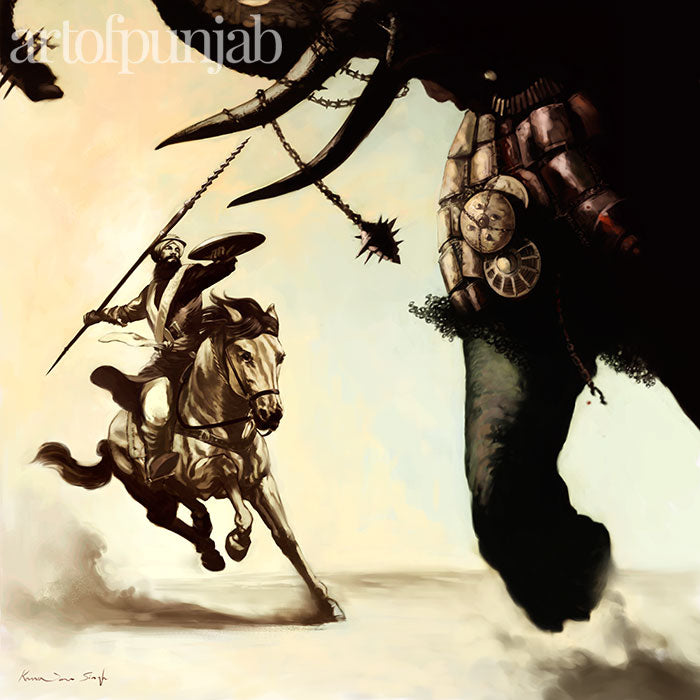-
Battle of Chumkaur 1705
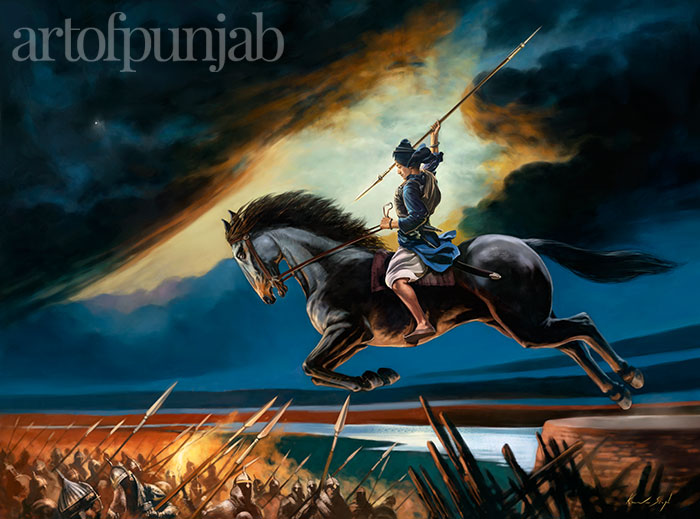
Baba Jujhar Singh
At the Battle of Chumkaur, Baba Jujhur Singh watched his brother Baba Ajit Singh attain Shaheedi. He desired to fight in the battlefield as well, though doing so meant certain death. He asked his father, Guru Gobind Singh, "Guru Sahib, permit me, dear father, to go where my brother has gone. Don't say that I am too young. I am your son. I am a Singh, a Lion, of yours. I shall prove worthy of you. I shall die fighting, with my face towards the enemy, with the Naam on my lips and the Guru in my heart." -
Battle of Chumkaur 1705
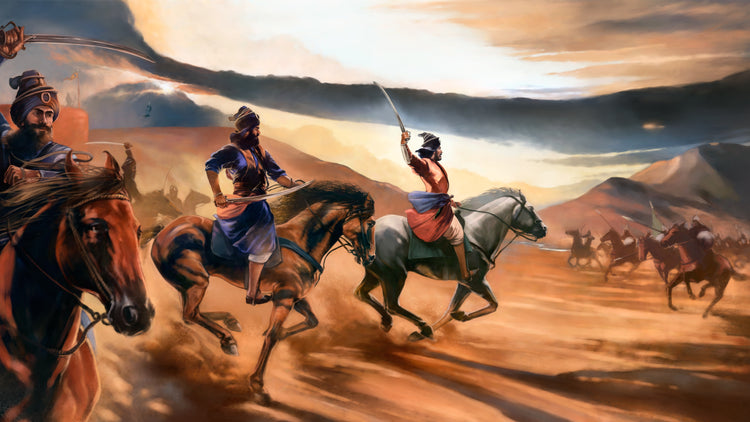
Baba Ajit Singh – The Khalsa Charge
In the prolonged siege of Anandpur in 1705, Sahibzada Ajit Singh displayed his qualities of courage and steadfastness. An unequal but grim battle commenced on 7 December 1704 in the words of Guru Gobind Singh's Zafarnama, a mere forty defying a hundred thousand. The besieged, after they had exhausted the meagre stock of ammunition and arrows, made sallies in batches of five each to engage the encircling host with sword and spear. Sahibzada Ajit Singh led one of the sallies and laid down his life fighting in the thick of the battle. He was 18 years old at the time of his supreme sacrifice for his faith. -
Battle of Anandpur 1700
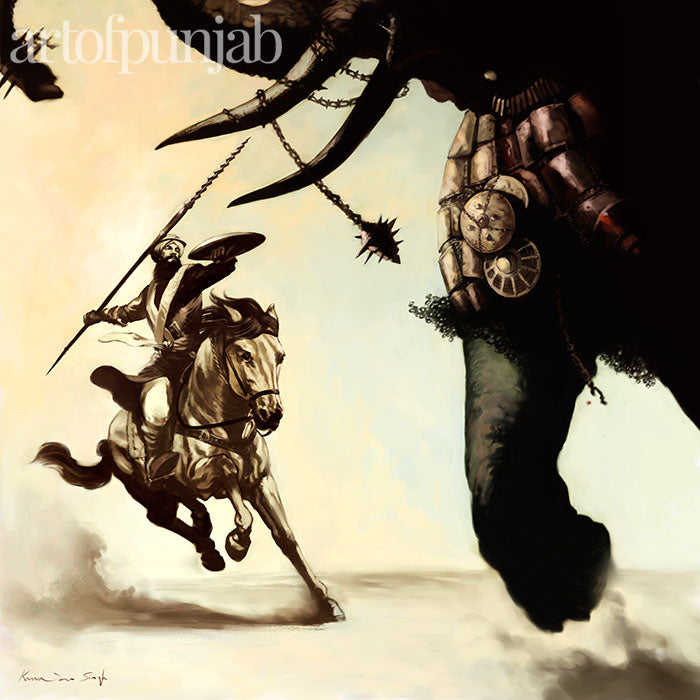
Bhai Bachittar Singh (Tonal) - Square
Initiated into the Khalsa on the historic first Vaisakhi Day, Bachittar Singh fought alongside Guru Gobind Singh in a number of battles in defense of Anandpur. This scene shows him in the famous single-handed combat with the enraged elephant charging at the Sikh fort of Lohgarh by the joint enemy forces of the Mughal Emperor Aurangzeb and the Hindu Hill Rajas. -
Battle of Anandpur 1700
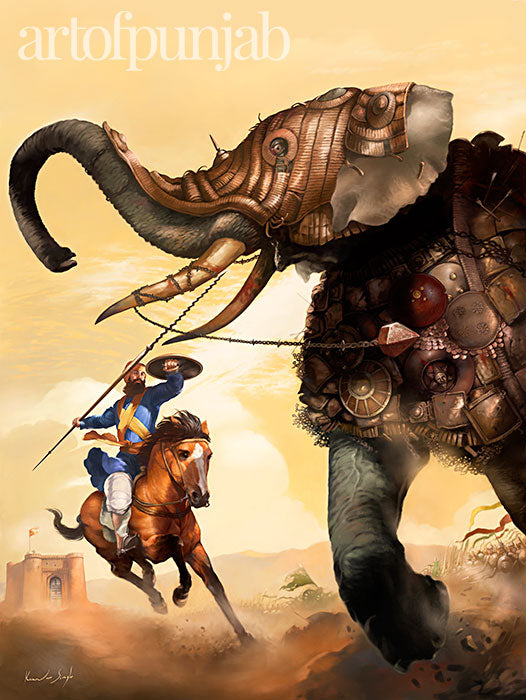
Bachittar Singh – Saint Soldier
Initiated into the Khalsa on the historic first Vaisakhi Day, Bachittar Singh fought alongside Guru Gobind Singh in a number of battles in defense of Anandpur. This scene shows him in the famous single-handed combat with the enraged elephant charging at the Sikh fort of Lohgarh by the joint enemy forces of the Mughal Emperor Aurangzeb and the Hindu Hill Rajas. The Guru gifted Bhai Bachittar with two essential things to defeat the enraged beast, the Nagni spear and the courage to use it. -
1675

Guru Tegh Bahadur’s Time
Guru Tegh Bahadur the ninth in the line of Guru Nanak, laid down his life in order to protect religious freedom for all of India which was under the oppressive rule of Mughal emperor Aurunzeb, who wished to convert the entire land to Islam. According to the Guru, living a truly spiritual life meant that one should neither oppress nor allow others to be oppressed. Sikh teachings have emphasized the basic human rights of equality, justice, freedom and the right to one's own religion. Under the inspiring guidance of Guru Tegh Bahadur, the Sikhs regained their confidence and continued to grow in numbers and resources. -
Battle of Muktsar 1705

Mai Bhago and the Chaali Muktey
Mai Bhag Kaur (Mai Bhago) was the inspiration behind the bravery of the martyrs known as the Chaali Muktey (the Liberated Forty) who died in the 1705 Battle of Muktsar. When the siege went on for months, in hunger and despair, 40 Sikhs from Mai Bhago’s village of Jhabal lost heart and renounced their loyalty to the Guru in writing and deserted him. News of the betrayal quickly reached Jhabal and the ears of Mai Bhago. Boiling with rage, she went around the village and exhorted the women folk not to receive the deserters into their homes unless the made amends for the disgrace they had brought home with them. Mai Bhago rode out and intercepted the forty deserters as they neared the boundaries of the village. She challenged them to return to the service of the Guru and brought these men back to the path of devotion and sacrifice. -
1705

Chhotey Sahibzadey
Zorawar Singh and Fateh Singh were the youngest of Guru Gobind Singh's sons, aged only 7 and 5 when they and their grandmother Mata Gujri were imprisoned by the tyrant Wazir Khan in Sirhind. Wazir Khab offered them safety if they converted to Islam or death if they refused. Though they were only young children physically, their spirit had been prepared for this moment since birth. The painting conveys their internal strength, honed as sons of Guru Gobind Singh and grandsons to Guru Tegh Bahadur, who also attained saheedi for refusing to give up the Sikh faith. Even though they are the ones being confined to darkness, they alone are the source of all radiance and light. That's why the painting shows the outside world painted in dark blood red like an open wound. The high walls of the fortress also question who is really imprisoned and who is really free. This painting Chhotey Sahibzadey reflects on their pure spirit which is prepared to embrace death and fears no one. -
1715
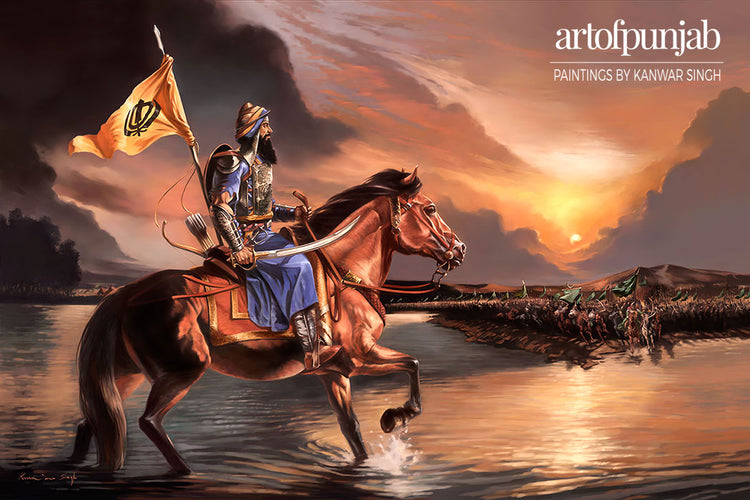
Banda Singh Bahadur - Sava Lakh Khalsa
Banda Singh Bahadur was handed the mantle of leadership from Guru Gobind Singh Ji himself. Born into the Hindu faith as Lachhman Dev, he encountered the Guru at Nander and immediately declared, “I am your Banda (slave).” Thus the Guru gave him the name Banda Singh Bahadur upon his initiation into the order of the Khalsa. After receiving the Guru’s blessing, Banda Bahadur became the first general of the Sikh panth. He amassed a force large enough to threaten the Mughal Empire and change the social, political and religious landscape of Punjab.“I will tell you, whenever men become so corrupt and wicked as to relinquish the path of equity and to abandon themselves to all kinds of excesses, then the Providence never fails to raise up a scourge like me to chastise a race so depraved; When the tyrants oppress their subjects to the limit, then God sends men like me on this earth to mete out his punishment to them.” – Banda Singh Bahadur
-
1753
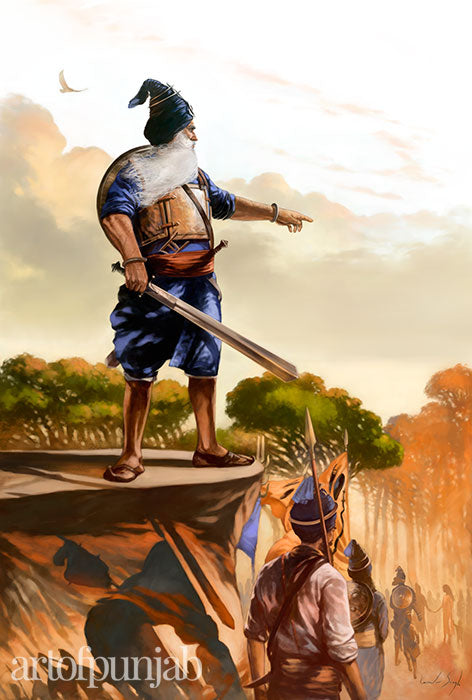
Baba Deep Singh Shaheed
1682-1753 Baba Deep drew a line with his Khanda and beseeched only those committed to giving their lives in defense of the Sikh faith to step over it. Five thousand Sikhs accompanied him on his journey to free Harimandir Sahib from the Afgan army that had desecrated it. Dressed as bridegrooms in fine clothing and festive ribbons, they joyously readied themselves to wed death. The painting speaks of this blessed journey and the mortal release experienced through their shaheedi spirit, where the spiritual fire upon which they cast their bodies also freed their souls. -
First World War
1914 - 1918
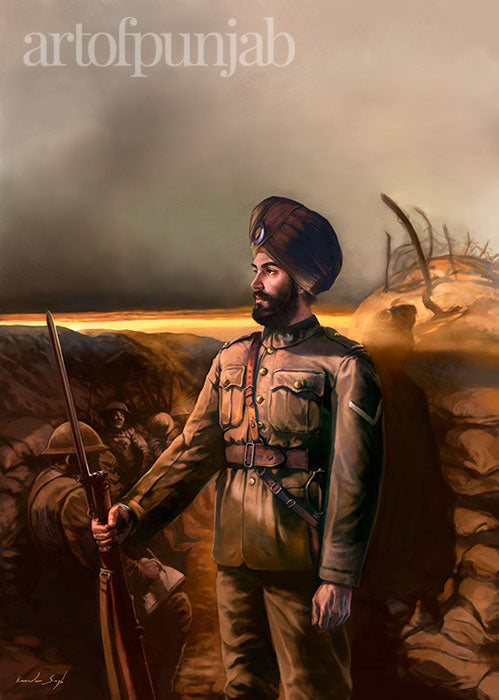
Stand on Guard for Thee
To commemorate the 100th Anniversary of Sikhs contribution to World War One, this painting represents a foray into the contemporary period of Sikh Military history. It deals with the role of Sikh men and women of various nationalities who lived through this epic confrontation of Nations. The title of the painting, taken from the Canadian National Anthem, reflects upon the willingness of Sikhs to fight against oppression throughout history. It is a testament to the spirit of Guru Gobind Singh, which forever emboldens the Khalsa to strive towards a greatness that surpasses humble beginnings. -
1995
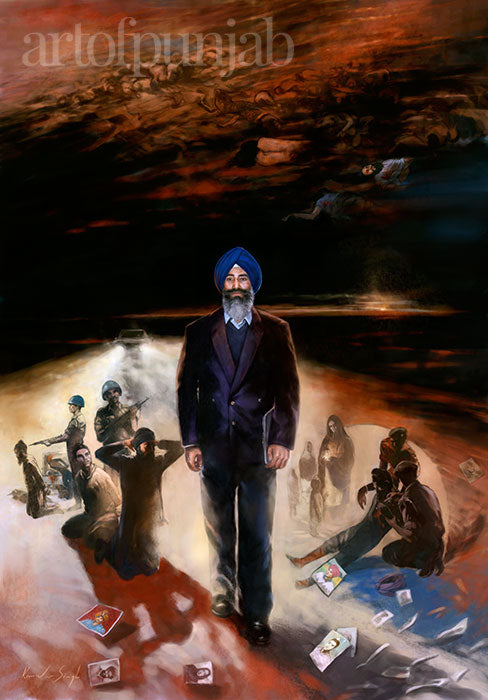
Jaswant Singh Khalra – The Witness
This painting chronicles the life's work of human rights activist Shaheed Jaswant Singh Khalra and the events of the bloody decade (1984 -1995) in Punjab. It depicts how government forces operated with complete impunity to end the Khalistan movement, and in doing so, carried out the secret murders of thousands of its' own citizens, many of them complete innocents. This portrait of Jaswant Singh Khalra and the state of Punjab speaks to the loss of humanity when power is asserted through terror and violence. In those desperate times, the Guru inspires great souls who act as our protectors, saving us from being engulfed by total darkness. In an inspirational speech, which was to be his last, Jaswant Singh Khalra declared: I challenge the darkness, if nothing else, then at least around myself, I will not let it settle. Around myself I will establish light."
Jaswant Singh Khalra was murdered at the age of 42, giving his life to the preservation of human rights in Punjab. To commemorate the incredible impact of his life, 42 rare Artist signed canvas prints will be released. All proceeds will go to Ensaaf, a charity dedicated to carrying forward his mission to end impunity and give voice to the disappeared. -
Battle of Anandpur 1700

Bhai Bachittar Singh (Tonal) - Wide
Initiated into the Khalsa on the historic first Vaisakhi Day, Bachittar Singh fought alongside Guru Gobind Singh in a number of battles in defense of Anandpur. This scene shows him in the famous single-handed combat with the enraged elephant charging at the Sikh fort of Lohgarh by the joint enemy forces of the Mughal Emperor Aurangzeb and the Hindu Hill Rajas.

